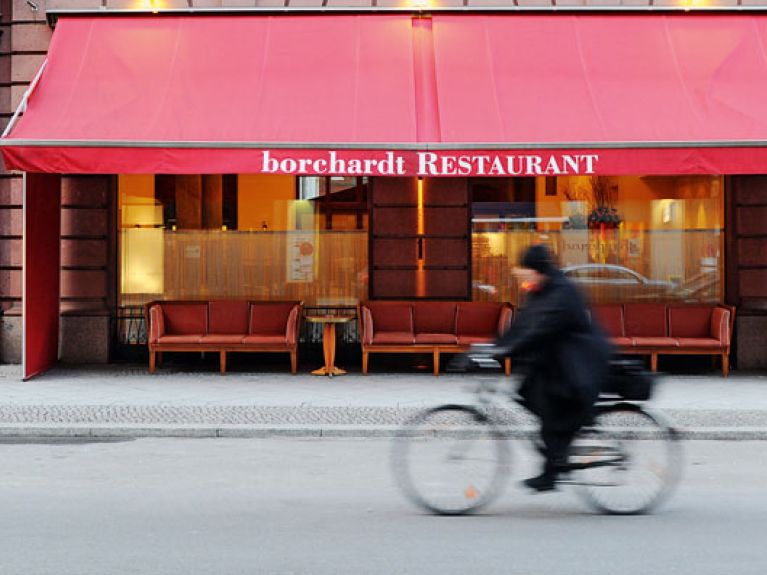The capital’s canteen
People don’t visit the Borchardt in Berlin’s Mitte district to eat schnitzel.

If you want to know what’s going on in Berlin, visit the Borchardt. It’s where former Chancellor Gerhard Schröder used to enjoy his schnitzel and where Chancellor Angela Merkel has held important meetings with her coalition partner. Former Foreign Minister Hans-Dietrich Genscher is also a regular guest. Located in Berlin’s Mitte district, the Borchardt might be described as the Republic’s canteen. It’s the place where politicians do their strategic planning and where lobbyists meet with journalists. It’s located right next to the government quarter and close to the Berlin offices of newspapers and TV stations. The Borchardt is frequented by designers during the Berlin Fashion Week and by film stars during Berlin’s film festival, the Berlinale. It’s a place where romances begin and end, where marriages have been arranged and estranged brothers have patched up their differences.
According to owner Roland Mary, the Borchardt is known in Los Angeles as The Schnitzel Place, after the dish for which the restaurant is famous. The menu consists mainly of hearty fare, with occasional borrowings from French cuisine. But the food is not what most people come for: the place is essentially a watering hole. It’s hard to explain the magic of the restaurant’s spacious dining room with its tall columns and velvet-upholstered seats. Berlin is a city that’s hard to grasp, but here you get an inkling of what it’s all about. That may have to do with the right mix of guests and the restaurant’s proximity to Berlin’s historical centre.
“The mix of guests is the most important thing about a restaurant,” explains Roland Mary. The Borchardt’s patrons include both Russians and Americans, both philosophers and businesspeople. “That’s catering as it should be,” says Roland Mary. The Borchardt is a place that is firmly anchored in the present but at the same time steeped in history. You sit there expecting Leonardo DiCaprio to come through the door at any moment. And he has been here, just like Madonna. The murmur of their voices still seems to linger in the air and you feel as if you are joining in their conversations.
It would be nice to show photographs of all the famous people that have visited the restaurant – from Jack Nicholson, who drew the eyes of all the other guests on his way to the toilets and was greeted by a spontaneous round of applause, to Barack Obama, who was pounced on by a female guest who managed to get around his bodyguards in order just to touch him. But there are no such photographs. During the Berlinale, the windows are actually covered over to protect celebrities from the paparazzi, and not even the waiting staff are allowed to have their pictures taken with guests. “If a restaurant is talked about too much, that is not a sign of good hostelry,” says Roland Mary, “because everyone knows that they won’t be left in peace.” His guests’ privacy is sacred to him.
Already a well-known wine tavern in the 19th century, the Borchardt is modelled on La Coupole in Paris. Its atmosphere is more reminiscent of a bistro than of a fine restaurant. It’s noisy rather than quiet, lively rather than peaceful. The waiting staff are attentive but not overbearing: guests can help themselves to another glass of wine – bottles are not removed from the tables as at some starred establishments.
The Borchardt strongly bears the stamp of its owner. He is mostly there by lunchtime and virtually every evening. Roland Mary can often be seen sitting with guests at one of the tables, but his manner is in no way intrusive. He chats with them as if they were his private dinner guests. Roland Mary’s look is both elegant and casual, like the men in Italian fashion advertisements. He nearly always wears a suit, with the top buttons of his shirt left undone.
Mary arrived in Berlin in the early 1980s and began working as a waiter at his then girlfriend’s pub. When he opened his own place shortly afterwards, he had finally made it. He opened the Borchardt in 1992. Mary has moved in all sorts of circles but he didn’t stick it for long in any of them. That’s probably what makes him the perfect host: being familiar with practically every different scene, he can change like a chameleon to suit his guests. He’s in his element in company. “Restaurateur is the ideal profession for me,” he says. “Being an Aquarian, I’m a passionate communicator.” There is occasionally something artificial about the Borchardt: it’s a make-believe world full of celebrities and the media crowd. But somehow the proper balance is struck. You feel that everyone is treated the same, whether celeb or minister. Or just an ordinary guest.

